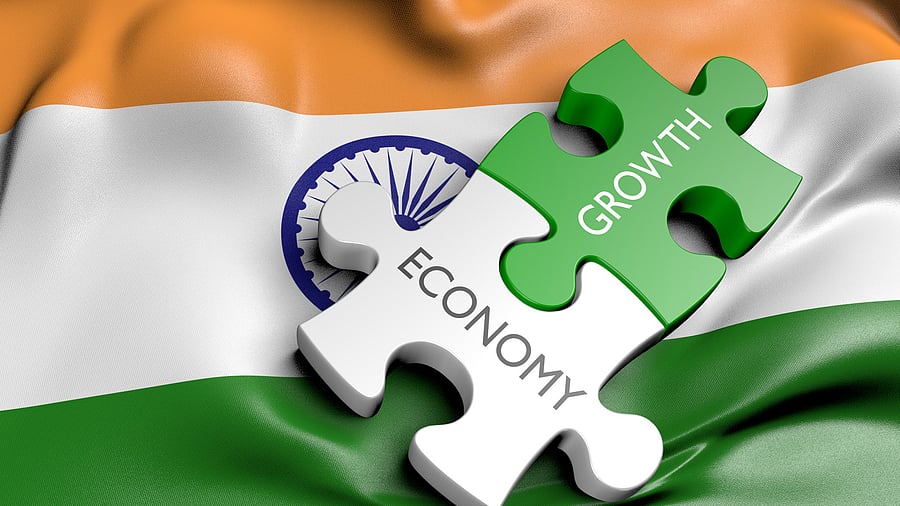
Image for representation.
Credit: iStock Photo
Notwithstanding the outcome of the Donald Trump tariff tantrums, India’s policymakers have an opportunity to reflect on the economic policies pursued over the last decade to rightly understand the barriers that have prevented it from becoming an economic miracle. India failed to capitalise its electoral dividends into economic profits back in 2014 by conspicuously staying away from undertaking structural reforms needed to jump-start the twin economic engines of investment and job creation.
Several factors have been at play. First, India’s share in the global manufacturing has remained steady at 2% even as the contribution of the private sector to India’s gross capital formation has fallen from 30.02% in 2012 to 26.41% in 2023.
Despite several incentives, ranging from the Production Linked Incentive (PLI) schemes to tax holidays, growth in the private sector capex has remained curiously moribund. India’s private sector has failed to capitalise on landmark reforms like the GST, which is no ordinary feat in a noisy democracy like India. The implications of a dormant investment in preventing an economic renaissance can be significant. In the presence of lacklustre consumption, there is limited benefit in public expenditure crowding private investment.
Global headlines of glittering airports dotting India’s many tier-2 and tier-3 cities without functional passenger capacity serve as a poignant reminder of the limits of governmental interventions in boosting demand. Is the private sector shackled by risk aversion? In a growing economy like India, risk aversion can be one of the biggest impediments. The government has a direct incentive in boosting risk-taking by discouraging oligopolistic behaviour evident in big conglomerates dominating the growth-sensitive sectors. To that extent, India being seen by the world as pro-business, but not necessarily pro-market, deserves attention.
Given this, the answer as to why India has failed to be seen as an economic miracle is eerily evident. Even as the government has done well in ameliorating distributional inefficiencies through the judicious deployment of DPI, more needs to be done to boost purchasing power by creating tangible and robust job opportunities. The latter can translate into higher demand, boosting consumption, thereby allowing the private sector to increase investment capacity.
Now that the so-called dual balance sheet problems — companies’ lackadaisical earnings and banks’ non-performing assets (NPA) — have been mitigated, the pubic sector banks need to appeal to institutional lending as Indian corporations report healthy earnings coupled with higher free cash flows. Capital market reforms, too, would go a long way in turning more foreign investors towards India from a long-term horizon. India’s ability to provide sustainable forms of both debt and equity capital at attractive rates remains one of the fundamental ways of giving a fillip to private capex. Towards this, the recent discussion by SEBI to introduce fractional shares remains a step in the right direction.
India has a major role to play in removing wide disparities in household incomes, as roughly 1% of the wealthy control more than 33% of the productive assets in the economy. While there have been some noticeable successes in the form of Apple and others building a manufacturing presence in India, their overall contribution to supporting the GDP remains far too insignificant.
Having a discernible purchasing power demanding aspirational goods and services remains one of the most compelling signals for foreign corporations to make a beeline in investments. This is verily the model adopted by China, whose GDP per capita at $13,127 sits comfortably at four times that of India. The model of mass affluence remains the most prominent factor in lending China to be such a powerful voice in the most consequential corridors of economic power.
India will have to work assiduously in removing economic inequities by focusing on regions which hitherto remain oblivion to India’s economic prosperity. Given the federal structure, it is imperative that state governments are empowered to incentivise both private and foreign investment to allay income anomalies.
India is too vast a country to permit a centralised approach for achieving economic egalitarianism. While these steps will take time in realising India’s full potential, India’s leaders must not miss the opportunity to court a working deal that ultimately results in creating last-mile opportunities for households.
(Ullas Rao is Assistant Professor of Finance at the Manipal Academy of Higher Education (MAHE) Dubai. X: @Ullasrao7.)
Disclaimer: The views expressed above are the author's own. They do not necessarily reflect the views of DH.